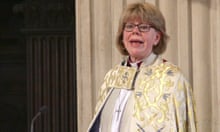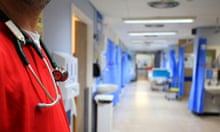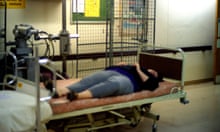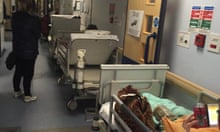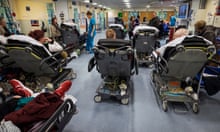Patients are finding it harder to get to see their own GP, in a trend that could damage people’s health, according to new research into a vital cornerstone of NHS care.
The number of patients in England who said they were able to get an appointment with their family doctor fell by 27.5% between 2012 and 2017, the study found. The authors and organisations representing the profession blamed GPs’ rising workloads, widespread shortages of family doctors and more GPs going part-time for the fall.
The researchers said that the sharp decline in regular contact between patients and their GP, which they call “relationship continuity”, could undermine people’s health. Evidence shows that people who see the same GP when they go to the surgery are more likely to have an ailment diagnosed early, take prescribed medications and access services to prevent ill-health.
“Relationship continuity of care declined by 27.5% over the period 2012-2017,” said Louis Levene and colleagues from the University of Leicester, whose findings were published online in the British Journal of General Practice on Wednesday.
The authors based their conclusion on an analysis of data collected for the annual GP Patient Survey, which is sent to more than 1 million patients from 6,500 GP surgeries.
Q&AWhat are the financial pressures on the NHS that have built up over the last decade?
Show
Between 2010-11 and 2016-17, health spending increased by an average of 1.2% above inflation and increases are due to continue in real terms at a similar rate until the end of this parliament. This is far below the annual inflation-proof growth rate that the NHS enjoyed before 2010 of almost 4% stretching back to the 1950s. As budgets tighten, NHS organisations have been struggling to live within their means. In the financial year 2015-16, acute trusts recorded a deficit of £2.6bn. This was reduced to £800m last year, though only after a £1.8bn bung from the Department of Health, which shows the deficit remained the same year on year.
Prof Kamila Hawthorne, vice chair of the Royal College of GPs, said: “We know our patients value the continuity of care they have with their family doctor, and GPs value this too, so it is sad to hear that it is declining in the traditional sense.
Family doctors should do what they can to ensure patients on their own list can see them, especially with one in four people having one or more long-term health problems, she added.
“GPs and our teams are rising to the challenge, despite facing resource and workforce pressures, to deliver this – albeit often in a different way than a patient always being able to see ‘their’ GP,” Hawthorne said.
Patients’ access to their own family doctor is in decline despite Jeremy Hunt, the health secretary, changing the GP contract in 2014 and again in 2015. The changes ensured that initially everyone over 75, and then every patient in England, had a “named accountable GP” who had overall responsibility for their care.
“The contractual requirement for patients to have a named doctor has, so far, not altered this steady decline in continuity, which coincides with longer waiting times for GP appointments, suggesting that workload pressures are once again creating problems for the doctor-patient relationship,” the paper says. “In the first nine months after these requirements were introduced, there was no improvement in continuity.”
The British Medical Association said GPs were struggling under the weight of “unsustainable pressures”.
“Though GPs and staff at surgeries continue to work hard to provide a high level of service, these figures are an indication of the growing impact of unsustainable pressures on general practice, said Richard Vautrey, chair of the BMA’s GPs committee.
“Through no fault of GPs, the needs and expectations of patients are increasingly being unmet, largely due to the failure to address increasing staff shortages and insufficient funding.”
Q&ADoes the UK have enough doctors and nurses?
Show
The UK has fewer doctors and nurses than many other comparable countries both in Europe and worldwide. According to the Organisation for Economic Co-operation and Development (OECD), Britain comes 24th in a league table of 34 member countries in terms of the number of doctors per capita. Greece, Austria and Norway have the most; the three countries with the fewest are Turkey, Chile and Mexico. Jeremy Hunt, the health secretary, regularly points out that the NHS in England has more doctors and nurses than when the Conservatives came to power in 2010. That is true, although there are now fewer district nurses, mental health nurses and other types of health professionals.
NHS unions and health thinktanks point out that rises in NHS staff’s workloads have outstripped the increases in overall staff numbers. Hospital bosses say understaffing is now their number one problem, even ahead of lack of money and pressure to meet exacting NHS-wide performance targets. Hunt has recently acknowledged that, and Health Education England, the NHS’s staffing and training agency, last month published a workforce strategy intended to tackle the problem.
Hunt had pledged to boost the number of GPs working in England by 5,000 between 2015 and 2020, but family doctor numbers have fallen recently.
Levene says that reduced spending on NHS primary care services at a time of heavier workloads for GPs was also a factor driving the trend.
The Department of Health and Social Care said: “We want to ensure that everyone has access to GP services, including routine appointments at evenings and weekends. The latest statistics show more than half the population is currently benefitting from more flexible appointments.
“To improve access to patients and availability of appointments, we’re investing an extra £2.4bn a year into general practice by 2021 and will recruit an additional 5,000 doctors.”



